Insights on Canadian Society
Language practices of children in Francophone families living outside Quebec
Archived Content
Information identified as archived is provided for reference, research or recordkeeping purposes. It is not subject to the Government of Canada Web Standards and has not been altered or updated since it was archived. Please "contact us" to request a format other than those available.
by Émilie Lavoie and René Houle
Start of text box
Overview of the study
Using data from the 2006 Survey on the Vitality of Official-Language Minorities (SVOLM), this study examines the language behaviour of children of Francophone parents living in a minority language environment during cultural or social activities. It also explores factors associated with the use of French during such activities. The focus is on two particular activities: reading and watching television.
- Among children of Francophone parents who were living in a French minority environment in 2006, 33% used French exclusively or primarily for reading, and 12% used French exclusively or primarily for watching television.
- Among children of Francophone parents who spoke French most often at home, 74% used French exclusively or primarily for reading, but 32% used French exclusively or primarily for watching television.
- Among children whose both parents had French as their mother tongue (i.e., “endogamous” families), 65% used French exclusively or primarily for reading, but 29% used French exclusively or primarily for watching television.
- In communities where French is the first official language spoken of less than 2% of the overall population of children, at least 50% of children of Francophone parents used only English for reading or watching television.
End of text box
Introduction
The transmission of French to children is a key issue in the development and vitality of official-language minority communities throughout the country. While the study of language transmission generally focuses on mother tongue and the language used at home and at school, language transmission can also be examined from other angles.
Using data from the Survey on the Vitality of Official-Language Minorities (SVOLM), this study examines the language choices of those childrenNote 1 in other circumstances, such as their daily activities. Although the SVOLM was conducted in 2006, it is unique in that it is a postcensal survey that was designed to collect information on the needs and practices of official-language minority communities in the areas of education, health and justice, and to produce useful information for the various departments and agencies that were involved in its development.Note 2
This article presents a number of highlights on the language behaviour of children under the age of 18 living outside Quebec with at least one Francophone parent, with a particular focus on reading and watching television. The article examines the possible influence of specific factors (main language used at home, the family’s linguistic composition and the presence of French in the community) on the language used by children in their daily activities.
Children’s personal, extracurricular and recreational activities
The SVOLM sheds light on languages used in five daily activities: television viewing, Internet use, participation in organized sports, participation in activities other than sports, and reading.
Among children who had at least one Francophone parent, French was more widely used in reading than in other activities (Chart 1). More specifically, the proportion of those who primarily or exclusively used French was 33% for reading, while it varied from 12% to 23% for the other four activities (including watching television). The proportion of those who primarily or exclusively used English to read was just under 50%, while it varied from 66% to 74% for the other activities.
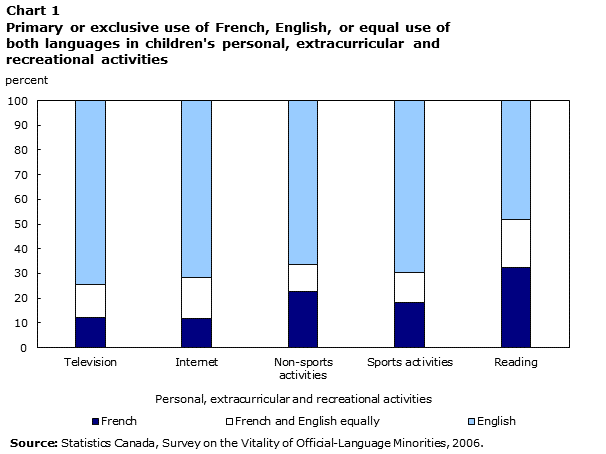
Description for chart 1
The title of the graph is "Chart 1 Primary or exclusive use of French, English, or both languages equally in children's personal, extracurricular and recreational activities."
This is a column stacked chart.
There are in total 5 categories in the horizontal axis. The vertical axis starts at 0 and ends at 100 with ticks every 10 points.
There are 3 series in this graph.
The vertical axis is "percent."
The horizontal axis is "Personal, extracurricular and recreational activities ."
The title of series 1 is "French."
The minimum value is 11.7 and it corresponds to "Internet."
The maximum value is 32.6 and it corresponds to "Reading."
The title of series 2 is "French and English equally."
The minimum value is 11 and it corresponds to "Non-sports activities."
The maximum value is 19.3 and it corresponds to "Reading."
The title of series 3 is "English."
The minimum value is 48.1 and it corresponds to "Reading."
The maximum value is 74.3 and it corresponds to "Television."
| French | French and English equally | English | |
|---|---|---|---|
| Television | 12.0 | 13.7 | 74.3 |
| Internet | 11.7 | 16.5 | 71.8 |
| Non-sports activities | 22.8 | 11.0 | 66.2 |
| Sports activities | 18.2 | 12.0 | 69.8 |
| Reading | 32.6 | 19.3 | 48.1 |
| Source: Statistics Canada, Survey on the Vitality of Official-Language Minorities, 2006. | |||
The differences in language use by children of Francophone parents living in a minority environment can be highlighted by examining the results associated with reading and television viewing.Note 3 This is because these two activities were the most prevalent among these children at the time of survey collection—as many as 98% of children of the Francophone minority engaged in readingNote 4 and 94% watched television, while about one-third did not participate in sports or non-sports activities and did not use the Internet in 2006.Note 5
Some factors are more likely to be associated with enhanced use of French in daily activities. These factors are examined below and include the language most spoken at home, the mother tongue of the parents, and the proportion of children in the community who have French as their first official language spoken.
Language used in daily activities and language spoken most often at home
Among children of Francophone parents, the language spoken at home was closely associated with the language used for reading. Of children who spoke French most often at home, 45% used only French for reading (Chart 2.1). Conversely, just over one-half of the children who spoke English most often at home used only that language for reading. Similarly, 46% of children who spoke French and English equally at home also used both languages equally for reading.
When those who used only French are combined with those who primarily used French (i.e., more French than English), the proportion of those who used French for reading rises to 74% among those who spoke French most often at home. Of those who primarily spoke English at home, 78% used English exclusively or primarily for reading.
However, English was used more than French for watching television, regardless of language spoken at home. Among children who spoke English most often at home, almost all (96%) watched television exclusively or primarily in English (Chart 2.2). Of those who spoke French and English equally at home, the proportion was 75%. Even among children who spoke French most often at home, 42% watched television exclusively or primarily in English, while 32% watched television exclusively or primarily in French.
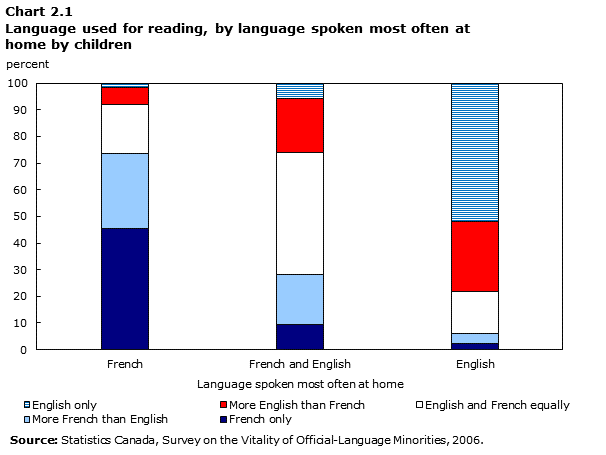
Description for chart 2.1
The title of the graph is "Chart 2.1 Language used for reading, by language spoken most often at home by children."
This is a column stacked chart.
There are in total 3 categories in the horizontal axis. The vertical axis starts at 0 and ends at 100 with ticks every 10 points.
There are 5 series in this graph.
The vertical axis is "percent."
The horizontal axis is "Language spoken most often at home."
The title of series 1 is "French only."
The minimum value is 2.3 and it corresponds to "English."
The maximum value is 45.4 and it corresponds to "French."
The title of series 2 is "More French than English."
The minimum value is 3.7 and it corresponds to "English."
The maximum value is 28.3 and it corresponds to "French."
The title of series 3 is "English and French equally."
The minimum value is 16 and it corresponds to "English."
The maximum value is 46 and it corresponds to "French and English."
The title of series 4 is "More English than French."
The minimum value is 6.4 and it corresponds to "French."
The maximum value is 26.2 and it corresponds to "English."
The title of series 5 is "English only."
The minimum value is 1.4 and it corresponds to "French."
The maximum value is 51.9 and it corresponds to "English."
| French only | More French than English | English and French equally | More English than French | English only | |
|---|---|---|---|---|---|
| French | 45.4 | 28.3 | 18.6 | 6.4 | 1.4 |
| French and English | 9.3 | 18.7 | 46.0 | 20.2 | 5.8 |
| English | 2.3 | 3.7 | 16.0 | 26.2 | 51.9 |
| Source: Statistics Canada, Survey on the Vitality of Official-Language Minorities, 2006. | |||||
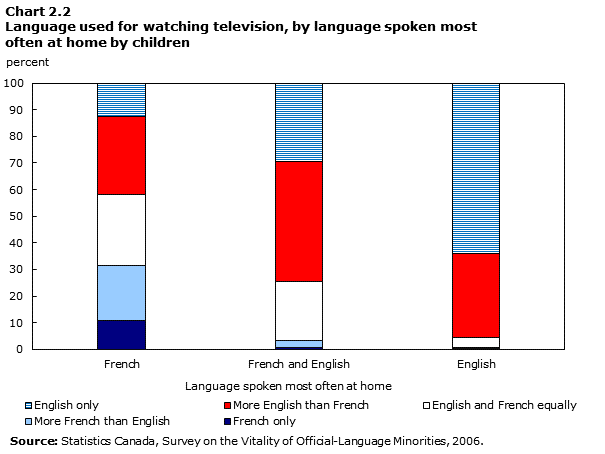
Description for chart 2.2
The title of the graph is "Chart 2.2 Language used for watching television, by language spoken most often at home by children."
This is a column stacked chart.
There are in total 3 categories in the horizontal axis. The vertical axis starts at 0 and ends at 100 with ticks every 10 points.
There are 5 series in this graph.
The vertical axis is "percent."
The horizontal axis is "Language spoken most often at home."
The title of series 1 is "French only."
The minimum value is 0.2 and it corresponds to "English."
The maximum value is 10.7 and it corresponds to "French."
The title of series 2 is "More French than English."
The minimum value is 0.3 and it corresponds to "English."
The maximum value is 20.8 and it corresponds to "French."
The title of series 3 is "English and French equally."
The minimum value is 3.9 and it corresponds to "English."
The maximum value is 26.5 and it corresponds to "French."
The title of series 4 is "More English than French."
The minimum value is 29.5 and it corresponds to "French."
The maximum value is 45.2 and it corresponds to "French and English."
The title of series 5 is "English only."
The minimum value is 12.5 and it corresponds to "French."
The maximum value is 63.9 and it corresponds to "English."
| French only | More French than English | English and French equally | More English than French | English only | |
|---|---|---|---|---|---|
| French | 10.7 | 20.8 | 26.5 | 29.5 | 12.5 |
| French and English | 0.5 | 2.9 | 21.9 | 45.2 | 29.5 |
| English | 0.2 | 0.3 | 3.9 | 31.6 | 63.9 |
| Source: Statistics Canada, Survey on the Vitality of Official-Language Minorities, 2006. | |||||
Children whose both parents had French as their mother tongue more likely to use French when reading
The language behaviour of children whose parents formed an endogamous Francophone couple was different from that of children whose parents formed an exogamous couple. Endogamous couples are those in which the mother tongue of both parents is French.Note 6 Exogamous couples are those in which one parent has French as his or her mother tongue, while the other does not. In this study, a non-Francophone couple means that none of the parents had French as their mother tongue, but could nevertheless understand and use French.
When both parents had French as their mother tongue, French was more widely used by the children in their personal, extracurricular or recreational activities. For example, 65% of children with two parents who had French as their mother tongue exclusively or primarily used French to read, while the use of French did not exceed 21% for other types of family linguistic composition (Chart 3.1). Similarly, 29% of children whose parents formed an endogamous Francophone couple watched television in French, compared with less than 5% of children from other types of families (Chart 3.2).
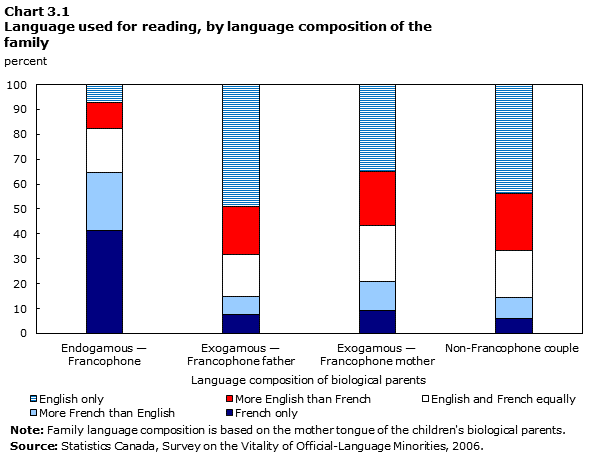
Description for chart 3.1
The title of the graph is "Chart 3.1 Language used for reading, by language composition of the family."
This is a column stacked chart.
There are in total 4 categories in the horizontal axis. The vertical axis starts at 0 and ends at 100 with ticks every 10 points.
There are 5 series in this graph.
The vertical axis is "percent."
The horizontal axis is "Language composition of biological parents."
The title of series 1 is "French only."
The minimum value is 6 and it corresponds to "Non-Francophone couple."
The maximum value is 41.4 and it corresponds to "Endogamous — Francophone."
The title of series 2 is "More French than English."
The minimum value is 6.9 and it corresponds to "Exogamous — Francophone father."
The maximum value is 23.1 and it corresponds to "Endogamous — Francophone."
The title of series 3 is "English and French equally."
The minimum value is 16.9 and it corresponds to "Exogamous — Francophone father."
The maximum value is 22.5 and it corresponds to "Exogamous — Francophone mother."
The title of series 4 is "More English than French."
The minimum value is 10.7 and it corresponds to "Endogamous — Francophone."
The maximum value is 23 and it corresponds to "Non-Francophone couple."
The title of series 5 is "English only."
The minimum value is 7 and it corresponds to "Endogamous — Francophone."
The maximum value is 49.2 and it corresponds to "Exogamous — Francophone father."
| French only | More French than English | English and French equally | More English than French | English only | |
|---|---|---|---|---|---|
| Endogamous — Francophone | 41.4 | 23.1 | 17.7 | 10.7 | 7.0 |
| Exogamous — Francophone father | 7.8 | 6.9 | 16.9 | 19.2 | 49.2 |
| Exogamous — Francophone mother | 9.3 | 11.4 | 22.5 | 21.7 | 35.2 |
| Non-Francophone couple | 6.0 | 8.3 | 18.9 | 23.0 | 43.8 |
|
Note: Family language composition is based on the mother tongue of the children's biological parents. Source: Statistics Canada, Survey on the Vitality of Official-Language Minorities, 2006. |
|||||
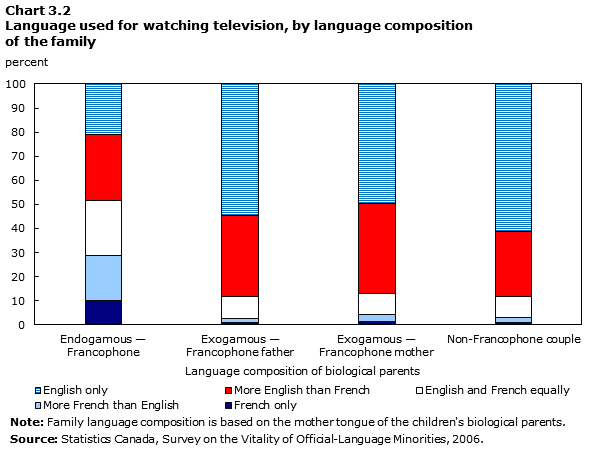
Description for chart 3.2
The title of the graph is "Chart 3.2 Language used for watching television, by language composition of the family."
This is a column stacked chart.
There are in total 4 categories in the horizontal axis. The vertical axis starts at 0 and ends at 100 with ticks every 10 points.
There are 5 series in this graph.
The vertical axis is "percent."
The horizontal axis is "Language composition of biological parents."
The title of series 1 is "French only."
The minimum value is 0.9 and it corresponds to "Exogamous — Francophone father."
The maximum value is 10.1 and it corresponds to "Endogamous —Francophone."
The title of series 2 is "More French than English."
The minimum value is 1.8 and it corresponds to "Exogamous — Francophone father."
The maximum value is 18.5 and it corresponds to "Endogamous —Francophone."
The title of series 3 is "English and French equally."
The minimum value is 8.6 and it corresponds to "Exogamous — Francophone mother."
The maximum value is 22.9 and it corresponds to "Endogamous —Francophone."
The title of series 4 is "More English than French."
The minimum value is 26.9 and it corresponds to "Non-Francophone couple."
The maximum value is 37.2 and it corresponds to "Exogamous — Francophone mother."
The title of series 5 is "English only."
The minimum value is 20.8 and it corresponds to "Endogamous —Francophone."
The maximum value is 61.1 and it corresponds to "Non-Francophone couple."
| French only | More French than English | English and French equally | More English than French | English only | |
|---|---|---|---|---|---|
| Endogamous —Francophone | 10.1 | 18.5 | 22.9 | 27.6 | 20.8 |
| Exogamous — Francophone father | 0.9 | 1.8 | 9.3 | 33.2 | 54.8 |
| Exogamous — Francophone mother | 1.3 | 3.2 | 8.6 | 37.2 | 49.7 |
| Non-Francophone couple | 1.0 | 2.0 | 9.0 | 26.9 | 61.1 |
|
Note: Family language composition is based on the mother tongue of the children's biological parents. Source: Statistics Canada, Survey on the Vitality of Official-Language Minorities, 2006. |
|||||
Even among children whose parents formed an endogamous Francophone couple, however, there was a significant difference in the use of French (on an exclusive or primary basis) between reading (65%) and television viewing (29%) activities. Among children from exogamous (or non-Francophone) couples, between 14% and 21% used French exclusively or primarily for reading, and less than 5% used it for watching television.
Among children from exogamous families, having a Francophone mother slightly increased the presence of French in the children’s language practices compared with linguistically exogamous families in which the father was a Francophone. For example, 15% of children whose father’s mother tongue was French mainly or exclusively used French for reading. This compared with 21% among those whose mother had French as her mother tongue.Note 7
The use of French by children is related to the language dynamics of the community
There is also a relationship between the language behaviour of children of the Francophone minority and the presence of French in the community. More precisely, French was more widely used in daily activities in census divisions (CDs) where a higher proportion of children had French as their first official language spoken (FOLS).
For example, in CDs where less than 2% of children had French as their FOLS, French was used exclusively or primarily for reading by 13% of Francophone children (Chart 4.1). In CDs where at least 25% of children had French as their FOLS, that same percentage was 67%. In terms of television viewing, the use of French climbed from 4% to 34%, depending on the intensity of French as a FOLS in the CD (Chart 4.2).
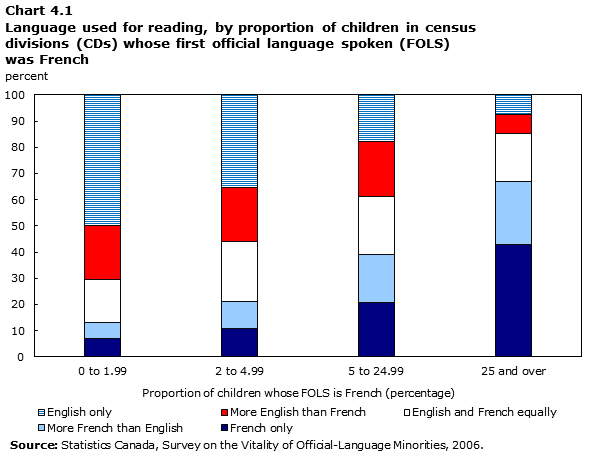
Description for chart 4.1
The title of the graph is "Chart 4.1 Language used for reading, by proportion of children in census divisions (CDs) whose first official language spoken (FOLS) was French."
This is a column stacked chart.
There are in total 4 categories in the horizontal axis. The vertical axis starts at 0 and ends at 100 with ticks every 10 points.
There are 5 series in this graph.
The vertical axis is "percent."
The horizontal axis is "Proportion of children whose FOLS is French (percentage)."
The title of series 1 is "French only."
The minimum value is 7.1 and it corresponds to "0 to 1.99."
The maximum value is 42.9 and it corresponds to "25 and over."
The title of series 2 is "More French than English."
The minimum value is 6.1 and it corresponds to "0 to 1.99."
The maximum value is 24.2 and it corresponds to "25 and over."
The title of series 3 is "English and French equally."
The minimum value is 16.2 and it corresponds to "0 to 1.99."
The maximum value is 22.8 and it corresponds to "2 to 4.99."
The title of series 4 is "More English than French."
The minimum value is 7.4 and it corresponds to "25 and over."
The maximum value is 21 and it corresponds to "5 to 24.99."
The title of series 5 is "English only."
The minimum value is 7.5 and it corresponds to "25 and over."
The maximum value is 49.8 and it corresponds to "0 to 1.99."
| French only | More French than English | English and French equally | More English than French | English only | |
|---|---|---|---|---|---|
| 0 to 1.99 | 7.1 | 6.1 | 16.2 | 20.8 | 49.8 |
| 2 to 4.99 | 10.6 | 10.5 | 22.8 | 20.7 | 35.3 |
| 5 to 24.99 | 20.8 | 18.2 | 22.1 | 21.0 | 17.9 |
| 25 and over | 42.9 | 24.2 | 18.0 | 7.4 | 7.5 |
| Source: Statistics Canada, Survey on the Vitality of Official-Language Minorities, 2006. | |||||
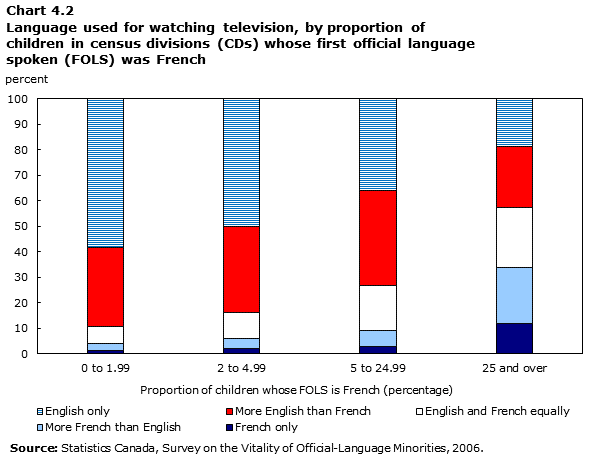
Description for chart 4.2
The title of the graph is "Chart 4.2 Language used for watching television, by proportion of children in census divisions (CDs) whose first official language spoken (FOLS) was French."
This is a column stacked chart.
There are in total 4 categories in the horizontal axis. The vertical axis starts at 0 and ends at 100 with ticks every 10 points.
There are 5 series in this graph.
The vertical axis is "percent."
The horizontal axis is "Proportion of children whose FOLS is French (percentage)."
The title of series 1 is "French only."
The minimum value is 1.3 and it corresponds to "0 to 1.99."
The maximum value is 12 and it corresponds to "25 and over."
The title of series 2 is "More French than English."
The minimum value is 2.6 and it corresponds to "0 to 1.99."
The maximum value is 21.9 and it corresponds to "25 and over."
The title of series 3 is "English and French equally."
The minimum value is 6.7 and it corresponds to "0 to 1.99."
The maximum value is 23.4 and it corresponds to "25 and over."
The title of series 4 is "More English than French."
The minimum value is 24.1 and it corresponds to "25 and over."
The maximum value is 37.3 and it corresponds to "5 to 24.99."
The title of series 5 is "English only."
The minimum value is 18.6 and it corresponds to "25 and over."
The maximum value is 58.4 and it corresponds to "0 to 1.99."
| French only | More French than English | English and French equally | More English than French | English only | |
|---|---|---|---|---|---|
| 0 to 1.99 | 1.3 | 2.6 | 6.7 | 31.0 | 58.4 |
| 2 to 4.99 | 2.0 | 4.1 | 10.3 | 33.4 | 50.2 |
| 5 to 24.99 | 2.9 | 6.2 | 17.6 | 37.3 | 36.0 |
| 25 and over | 12.0 | 21.9 | 23.4 | 24.1 | 18.6 |
| Source: Statistics Canada, Survey on the Vitality of Official-Language Minorities, 2006. | |||||
Conversely, children of Francophone parents were less likely to use only English in their daily activities in communities that had a higher degree of French presence. The exclusive use of English for reading declined from 50% (in areas where less than 2% of children in the CD had French as their FOLS) to 8% in areas where that indicator was 25% or more. Similarly, the exclusive use of English for watching television fell from 58% in CDs with the lowest proportions of French as a FOLS, to 19% in CDs that had the highest proportions of French as a FOLS.
In summary, the results of this study show that children from families that are not speaking French most often at home, those whose parents form an exogamous or non-Francophone couple (based on their mother tongue), and those living in CDs with a smaller proportion of children who had French as their FOLS are significantly more likely to use English for reading and television viewing. Although a greater presence of French at home or in the community is related to an increased use of French in cultural activities—particularly reading—the use of English among children living in a minority situation remains significant. Readers interested in obtaining more information are invited to read the detailed analytical report, titled Language Practices of Children in Francophone Families Living in a Minority Linguistic Environment.
Émilie Lavoie is an analyst in Statistics Canada’s Social and Aboriginal Statistics Division and René Houle is a senior analyst in the same division.
Start of text box
Data sources, methods and definitions
Data sources
The data for this article comes from the Survey on the Vitality of Official-Language Minorities (SVOLM) carried out by Statistics Canada in 2006 in collaboration with a number of federal departments and agencies. The purpose was to collect relevant information for the measurement and evaluation of key indicators of the vitality of minority language communities in Canada.Note 8 This survey was also designed to add to the language-related information relevant to official-language minorities that is generally available and limited to censuses.
The SVOLM target population is that of official-language minorities—English-speaking people in Quebec and French-speaking people in the rest of Canada. For the purposes of this study, the target population was limited to French-speaking people who lived outside Quebec and who were part of the SVOLM sample of “children”. Specifically, the sample used for this study is composed of persons under the age of 18 who had at least one parent who was a member of the Francophone minority and who lived outside the province of Quebec. The SVOLM is the only survey conducted by Statistics Canada on the specific issue of language use by Francophone minority children, and the information contained in this study was produced to meet the needs of the survey partners.
The Francophone minority in the SVOLM includes persons who had indicated that (a) French is their mother tongue, alone or with another language; (b) those whose mother tongue is a non-official language and who, of the two official-languages, know only French; or c) those whose mother tongue is a non-official language, who know both French and English, and who speak either a non-official language or French, alone or with another language, most often at home.
This study is based on a sample of 9,705 respondents representing 314,470 children. Of the latter, 23% lived in the western provinces, 34% in southern Ontario, 24% in northern and eastern Ontario, and 20% in the Atlantic provinces (mainly in New Brunswick).
End of text box
- Date modified:

